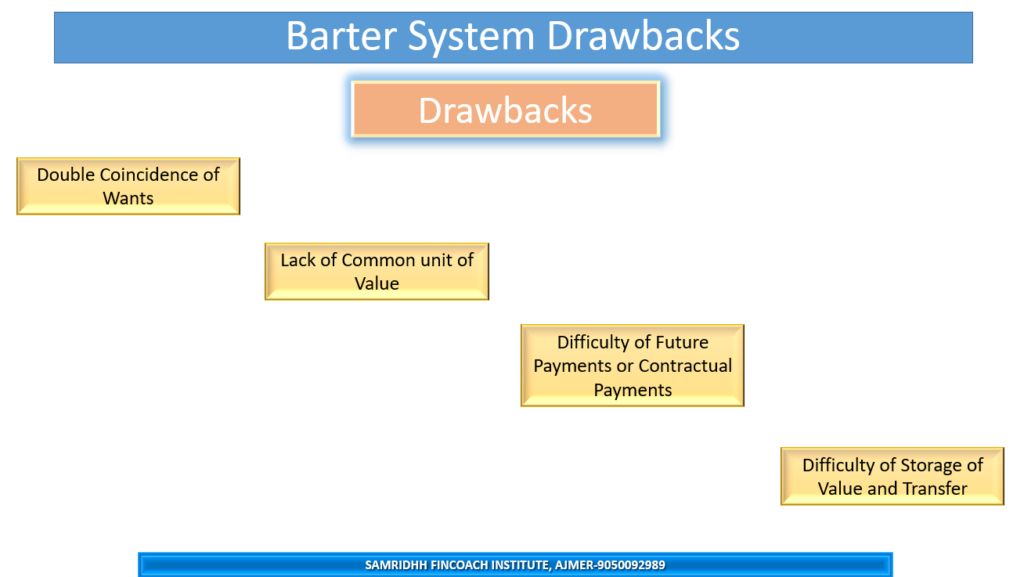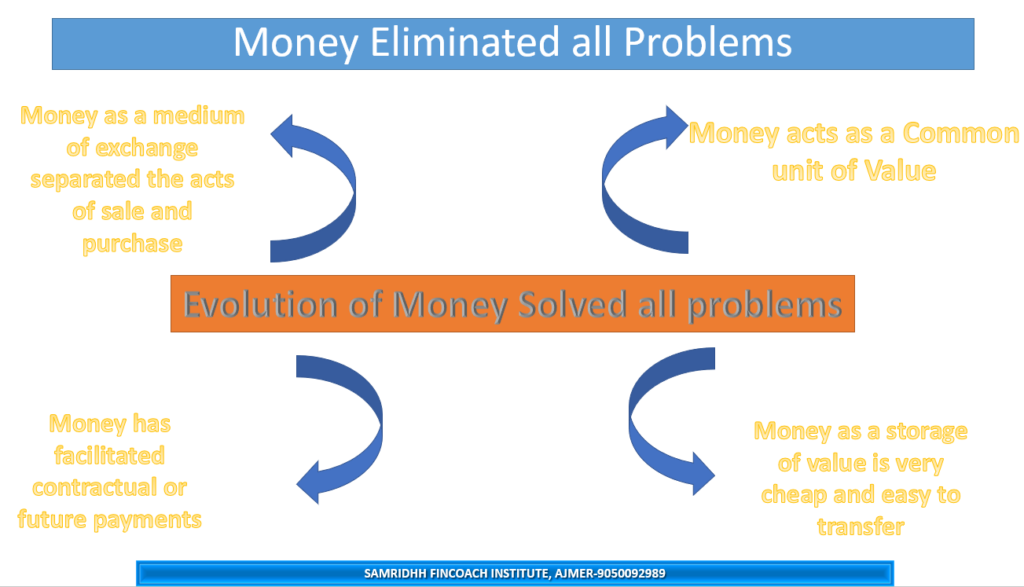The barter system is a system of exchange where goods and services are traded directly without the use of money. It is an ancient form of trade that was used before money was invented.

However, the barter system has several limitations that make it inefficient and impractical in the modern economy. Some of these limitations are:
- Lack of double coincidence of wants: This means that both parties in a barter exchange must have what the other party wants and be willing to trade it. For example, if a farmer wants to exchange wheat for cloth, he must find a weaver who has cloth and wants wheat. However, such a match is very rare and difficult to find. In Other words, you and the person you want to trade with must both have something that the other person wants and be happy to exchange it. For example, suppose you have a toy car and you want a teddy bear. You need to find someone who has a teddy bear and wants a toy car. But what if you can’t find such a person? Or what if the person who has a teddy bear wants something else, like a doll or a book? Then you won’t be able to trade your toy car for a teddy bear. That’s why it is hard to find a good match in the barter system.
- Lack of a common measure of value: This means that there is no standard unit of value to compare the worth of different goods and services in a barter exchange. For example, how many eggs are equal to one television? How many books are equal to one bicycle? Without a common measure of value, it is hard to determine the exchange ratios and ensure fair trade. Thus there is no way to tell how much something is worth compared to something else in the barter system. For example, how many cookies are equal to one ice cream? How many crayons are equal to one coloring book? Without a common measure of value, it is hard to decide how much to trade and make sure that both sides are getting a fair deal.
- Indivisibility of certain goods: This means that some goods cannot be easily divided into smaller units without losing their value or utility. For example, a cow cannot be split into half to exchange for other goods. Similarly, a painting or a sculpture cannot be cut into pieces to trade for other items. Some things cannot be easily split into smaller parts without losing their value or usefulness. For example, suppose you have a bicycle and you want to trade it for some candy. But the person who has the candy only wants half of your bicycle. How can you cut your bicycle into two pieces without breaking it or making it useless? Similarly, suppose you have a painting or a puzzle and you want to trade it for some toys. How can you tear your painting or puzzle into pieces without ruining it or making it incomplete?
- Difficulty in storing value: This means that some goods cannot be stored for long periods of time without deteriorating or losing their value. For example, food items like fruits, vegetables, meat, etc., can spoil or rot if not consumed or preserved properly. Similarly, some services like haircuts, massages, etc., cannot be stored or saved for future use. This some things cannot be kept for a long time without getting spoiled or losing their value. For example, suppose you have some bananas and you want to trade them for some chocolates. But the person who has the chocolates is not available right now and asks you to come back later. What will happen to your bananas if you wait too long? They will become ripe and then rotten, and nobody will want them anymore. Similarly, suppose you have some services like singing or dancing and you want to trade them for some games. What will happen if you don’t use your services right away? You can’t store them or save them for later, and they will be wasted.
- Difficulty in making deferred payments: This means that some transactions cannot be completed at the same time or place and require future payments or credit arrangements. For example, if a student wants to exchange tuition fees for tutoring services, he cannot pay the fees until he completes his course. Similarly, if a builder wants to exchange his labor for a house, he cannot get the house until he finishes his work. However, under the barter system, there is no guarantee that the future payments will be made or accepted in the same form or value. So some trades cannot be done at the same time or place and need future payments or promises. For example, suppose you want to learn how to play the piano and you want to trade your homework help for piano lessons. You can’t pay your homework help until you finish your homework, and you can’t get your piano lessons until you meet your teacher. How can you make sure that both sides will keep their promises and pay each other later? However, under the barter system, there is no guarantee that the future payments will be made or accepted in the same way or value.
- Difficulty of Transfer of Value: This means that some goods are bulky, heavy, or fragile and cannot be easily moved or transported from one place to another without losing their value or quality. For example, suppose you have a piano and you want to trade it for some furniture. How can you carry your piano to the person who has the furniture? You will need a truck or a trailer to move it, and you will also need to be careful not to damage it on the way. Similarly, suppose you have some pottery or glassware and you want to trade it for some clothes. How can you pack your pottery or glassware without breaking them? You will need a lot of bubble wrap or newspaper to protect them, and you will also need a lot of space to store them. These are some of the challenges of transferring value in the barter system that make it costly and risky to trade things with other people.
These are some of the major disadvantages of the barter system that make it unsuitable for the complex and dynamic needs of the modern economy.

Therefore, money was invented as a medium of exchange that overcomes these limitations and facilitates trade and commerce. Money has the following characteristics:
- Money has separated the acts of sale and purchase
- It is generally accepted as a means of payment by everyone.
- It has a stable and uniform value that can be used to measure and compare the worth of different goods and services.
- It is divisible into smaller units without losing its value or utility.
- It is durable and can be stored for long periods of time without deteriorating or losing its value.
- It is portable and can be easily carried and transferred from one place to another.

Money also enables specialization, innovation, economic growth, and development by reducing transaction costs and increasing efficiency and productivity.